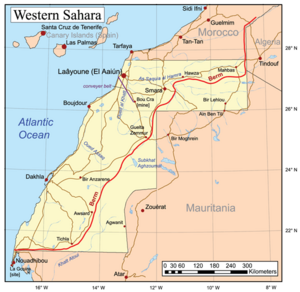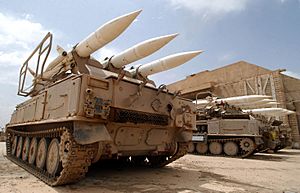First Battle of Amgala facts for kids
Quick facts for kids First Battle of Amgala |
|||||||
|---|---|---|---|---|---|---|---|
| Part of the Western Sahara War | |||||||
|
|||||||
| Belligerents | |||||||
(alleged by Morocco) |
|||||||
| Commanders and leaders | |||||||
| Strength | |||||||
| 2 battalions of 600 men | 1 battalion of 400 men | ||||||
| Casualties and losses | |||||||
| 440 killed (Polisario claim) 400 killed (Algerian claim) 2 Killed, 16 wounded (Moroccan claim) 1 Moroccan F-5 aircraft shot down |
200 killed 106–118 captured (Moroccan claim) |
||||||
The First Battle of Amgala was a fight that happened between January 27 and 29, 1976. It took place near the Amgala oasis in Western Sahara. This area is about 260 kilometers (160 miles) west of the border with Algeria.
During this battle, soldiers from the Royal Moroccan Armed Forces attacked units from the Algerian Army. The Algerians fought for 36 hours before they pulled back. However, the fighting in Amgala wasn't over. A few weeks later, in February 1976, the Polisario Front defeated Moroccan troops in the Second Battle of Amgala.
At the time, Western Sahara was one of the last places in Africa still controlled by a European country, Spain. Both Morocco and the Polisario Front wanted control of this land. The Polisario Front is a group of local people called the Sahrawi people. They had been fighting for independence since 1973.
The United Nations had asked for a vote to let the people decide their future. But in November 1975, Spain made a deal to split the land between Morocco and Mauritania. No vote was held. By January 1976, Morocco controlled most towns in its assigned area. Thousands of Sahrawi people were fleeing to Algeria.
Algeria said its troops were helping these refugees with food and medicine at Amgala. Morocco, however, claimed the Algerian soldiers were heavily armed and helping the Polisario Front. The Moroccan attack happened on the night of January 27. The Algerians left the area on January 29. The exact number of people killed is not clear, but over 100 Algerian soldiers were captured. This battle brought Algeria and Morocco very close to a full-scale war.
| Top - 0-9 A B C D E F G H I J K L M N O P Q R S T U V W X Y Z |
What Led to the Battle?
Western Sahara is a large area with few people. It used to be a Spanish colony called Spanish Sahara. Most of its people are Sahrawi people, who are nomads of mixed Arab and Berber background.
Since 1966, the United Nations General Assembly had asked Spain to let the people of Western Sahara vote on their future. This request was repeated many times. In May 1973, the Polisario Front was formed to fight for independence. Algeria helped the Polisario and Sahrawi refugees by giving them a safe place near Tindouf. Over time, the Polisario gained control of much of the inland areas.
In November 1975, Spain signed the Madrid Accords. This agreement divided Western Sahara between Morocco and Mauritania without a public vote. The details of this deal were kept secret. Morocco's army entered Dakhla in January 1976. Mauritanian troops joined them. On January 12, the last Spanish soldiers left Western Sahara.
Algeria was not part of the Madrid Accords. It started a campaign to support the Sahrawi people's right to decide their own future. By the end of 1975, Algeria had sent troops into Western Sahara or the nearby Tindouf area. Many Moroccans were also expelled from Algeria. About 40,000 refugees were fleeing eastward from the Moroccan forces.
The Battle at Amgala
In January 1976, the Amgala waterhole was a stop for refugees going to Algeria. Algerian troops were there to help them. Algeria said its soldiers were giving food and medical supplies to the refugees.
Morocco, however, claimed the Algerian troops were heavily armed. They had field guns, mortars, and anti-aircraft weapons. Some reports also said Polisario fighters were at Amgala. Algeria might have given them SA-6 anti-aircraft missiles. These missiles could help Polisario defend against Moroccan planes. After the battle, Morocco showed reporters Soviet-made missiles with Algerian army markings at the site.
On the night of January 27, Moroccan troops surprised the Algerian soldiers at Amgala. The fighting lasted for 36 hours. Moroccan sources said about 1,200 men were involved, including Algerian soldiers and Sahrawi fighters. The Algerians pulled back on January 29.
A Polisario spokesperson claimed 440 Moroccans were killed. Morocco said only two of its soldiers died and fourteen were hurt. They also claimed about 200 Algerians were killed and 109 were captured. Morocco also said they captured twelve Sahrawi fighters from the Polisario Front. The Algerian newspaper El Moudjahid reported 400 Moroccan deaths. Officials from the International Red Cross confirmed the number of Algerian prisoners. They visited them near Rabat.
What Happened After the Battle?
The day after the attack, on January 28, Algerian President Houari Boumediene sent messages to leaders worldwide. He said Algeria cared about the Sahrawi people's right to decide their future. He also said they faced a terrible situation. Algeria also shared its views with the United Nations. They held meetings with Arab leaders. Egypt tried to help solve the problem. It asked for a ceasefire and a meeting between the leaders of Morocco, Algeria, and Egypt. But this meeting did not happen. Algeria then started giving weapons and training to Polisario forces.
On February 3, 1976, Morocco said it was willing to let groups like the Arab League or the United Nations help solve the disagreement with Algeria. The U.N. Secretary General chose Olof Rydbeck as a mediator. Algeria welcomed Rydbeck, but Morocco was more cautious. He visited Western Sahara in February. He talked to some local people but could not meet Polisario representatives.
While these talks were happening, Morocco and Mauritania continued to take control of the territory. On February 12, 1976, the Moroccan army took Al Mahbes. This town is close to the Algerian border and controls a route to Tindouf. The Polisario could not defeat the Moroccan army in big battles. So, they started using guerrilla tactics. This meant quick attacks and then retreating to create unsafe areas.
Fighting started again at Amgala in February 1976. On the night of February 14–15, a force attacked the Moroccan soldiers left at Amgala. Many Moroccan soldiers were killed. The Moroccan base was almost completely destroyed. King Hassan II of Morocco immediately accused Algeria of being involved. He said Algerians used powerful weapons. Algeria denied this, saying only Polisario forces were involved.
These two battles at Amgala were the only times Algerian and Moroccan troops directly fought each other during the Western Sahara War. Later, in February, Algeria worked to get the Organisation of African Unity to recognize the Polisario Front. Spain officially left the territory on February 27, 1976. On that day, Polisario announced the creation of the Sahrawi Arab Democratic Republic (SADR). Algeria recognized SADR on March 6, 1976. The next day, Morocco ended its diplomatic relations with Algeria. Later in 1976, Polisario took Amgala back. Morocco then took it again in May 1977.
Ten years later, relations between Algeria and Morocco improved. In May 1987, 150 Moroccan prisoners of war were exchanged for 102 Algerian soldiers. These Algerians had been captured during the First Battle of Amgala in 1976. More fighting happened at Amgala in 1989, in what was called the second Battle of Amgala. Polisario fighters attacked and briefly defeated Moroccan troops before retreating. Morocco then took the area back.
Investigations into Civilian Deaths
In April 2013, experts from the University of the Basque Country and the Aranzadi Science Society started an investigation. Sahrawi families had asked them to look into human remains found near Amgala. DNA tests and forensic studies were done.
In September 2013, the team concluded that eight Sahrawi civilians, including two children, had been arrested in February 1976. They were arrested by a Moroccan military patrol and then killed by gunfire. Their bodies were buried at the site. Dr. Carlos Martin Beristain, one of the experts, stated that finding their remains at the spot suggests they were killed without a proper trial.
Morocco had its own group, the Equity and Reconciliation Commission (IER), which started in 2004. This group looked into missing persons and other issues. However, the IER had not given information about these eight people. Another Moroccan group, the Consultative Council on Human Rights (CCDH), also investigated four of the eight missing persons. The CCDH said these four people were arrested by Moroccan soldiers near Amgala in 1976. They claimed these people were taken to a military base in Smara and later died there.
A former Moroccan soldier, M'barek Daoudi, said in an interview that he saw two Sahrawi women killed in the Amgala area on February 12, 1976.
See also
 In Spanish: Primera batalla de Amgala para niños
In Spanish: Primera batalla de Amgala para niños
Images for kids





